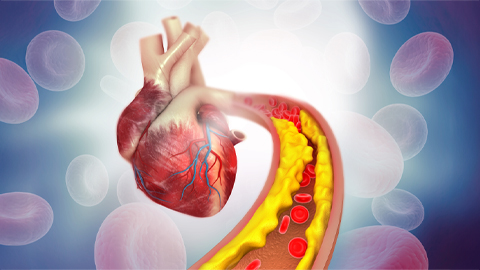Ubiquitination by TRIM13: An ingredient contributing to diet-induced atherosclerosis
Cardiovascular diseases are the leading cause of death globally, taking about 17.9 million lives each year. Among these disorders of the heart and blood vessels, atherosclerosis is the primary cause of mortality. Cases of atherosclerosis-related diseases are rising in Western countries, making prevention and treatment increasingly important.
As atherosclerosis develops, fatty deposits, called plaque, accumulate in the artery walls, narrowing the vessels and reducing blood flow. The plaque can eventually burst, forming a blood clot that may block the artery or travel to another part of the body, leading to complications such as heart attack and strokes.

Cholesterol accumulation in the inner arterial wall contributes to plaque formation. Macrophages and smooth muscle cells of arterial origin take up cholesterol and other lipids, forming foam cells, which then promote further foam cell formation and lesion progression. While foam cell formation is critical in the development of atherosclerosis, researchers know little about the molecular mechanisms driving its origin, making it difficult to develop therapies.
A recent study published in the Journal of Biological Chemistry, led by a group of researchers from Gadiparthi N. Rao’s laboratory at the University of Tennessee Health Science Center, found that tripartite motif-containing protein 13, or TRIM13, plays a role in diet-induced atherosclerosis by disrupting cholesterol homeostasis, suggesting it could be a therapeutic target. TRIM13 belongs to the family of enzymes called E3 ubiquitin ligases, which attach ubiquitin to target proteins, marking them for degradation.
“Years ago, when we were studying atherosclerosis, we found that when mice were fed a Western diet — high in fat and sucrose — the transporters responsible for mediating cholesterol efflux were ubiquitinated and degraded,” Rao said.
In 2018, Monoranjan Boro, a postdoctoral fellow in Rao’s lab, used mice that were genetically modified to develop atherosclerosis and found that TRIM13 was highly expressed in the mice fed a Western diet compared to those on a standard chow diet.
In this study, the team found that a Western diet caused a decrease in liver X receptors alpha and beta, or LXRα/β, and their target genes ATP binding cassette A1 and G1, or ABCA1 and ABCG1, in the aorta and peritoneal macrophages of mice. LXRα/β are transcription factors that control the expression of ABCA1 and ABCG1, which are cholesterol transporters that mediate cholesterol efflux from cells. Once cholesterol leaves the cells, it can travel through the bloodstream to the liver, where it is converted into bile salts which are excreted from the body.
Using a mouse that has been genetically altered to lack TRIM13, the team found that the absence of this enzyme reduced atherosclerotic lesions and restored LXRα/β protein levels. Looking at the difference between control and Western diets, they found that the Western diet induced extensive ubiquitination and degradation of LXRα/β proteins and inhibited ABCA1 and ABCG1-mediated cholesterol efflux in peritoneal macrophages, and that TRIM3 deletion reversed this effect. The team also found that TRIM13 ubiquitinated suppressor of cytokine signaling 1/3, or SOC1/3, which correlated with increased levels of CD36, a surface protein that facilitates fat uptake into cells. Deleting TRIM13 reduced CD36 expression and foam cell formation.
“If TRIM13 plays a major role in atherosclerosis, we could potentially develop inhibitory molecules targeting this E3 ligase to treat the disease,” Rao said.
When asked about future directions, Rao stressed the need to understand the role of different cell types in atherosclerosis. “The key question is whether smooth muscle cells or macrophages play a more significant role in TRIM13-mediated atherosclerosis.”
Enjoy reading ASBMB Today?
Become a member to receive the print edition four times a year and the digital edition monthly.
Learn moreGet the latest from ASBMB Today
Enter your email address, and we’ll send you a weekly email with recent articles, interviews and more.
Latest in Science
Science highlights or most popular articles

Bacteriophage protein could make queso fresco safer
Researchers characterized the structure and function of PlyP100, a bacteriophage protein that shows promise as a food-safe antimicrobial for preventing Listeria monocytogenes growth in fresh cheeses.

Building the blueprint to block HIV
Wesley Sundquist will present his work on the HIV capsid and revolutionary drug, Lenacapavir, at the ASBMB Annual Meeting, March 7–10, in Maryland.

Gut microbes hijack cancer pathway in high-fat diets
Researchers at the Feinstein Institutes for Medical Research found that a high-fat diet increases ammonia-producing bacteria in the gut microbiome of mice, which in turn disrupts TGF-β signaling and promotes colorectal cancer.

Mapping fentanyl’s cellular footprint
Using a new imaging method, researchers at State University of New York at Buffalo traced fentanyl’s effects inside brain immune cells, revealing how the drug alters lipid droplets, pointing to new paths for addiction diagnostics.

Designing life’s building blocks with AI
Tanja Kortemme, a professor at the University of California, San Francisco, will discuss her research using computational biology to engineer proteins at the 2026 ASBMB Annual Meeting.

Cholesterol as a novel biomarker for Fragile X syndrome
Researchers in Quebec identified lower levels of a brain cholesterol metabolite, 24-hydroxycholesterol, in patients with fragile X syndrome, a finding that could provide a simple blood-based biomarker for understanding and managing the condition.

